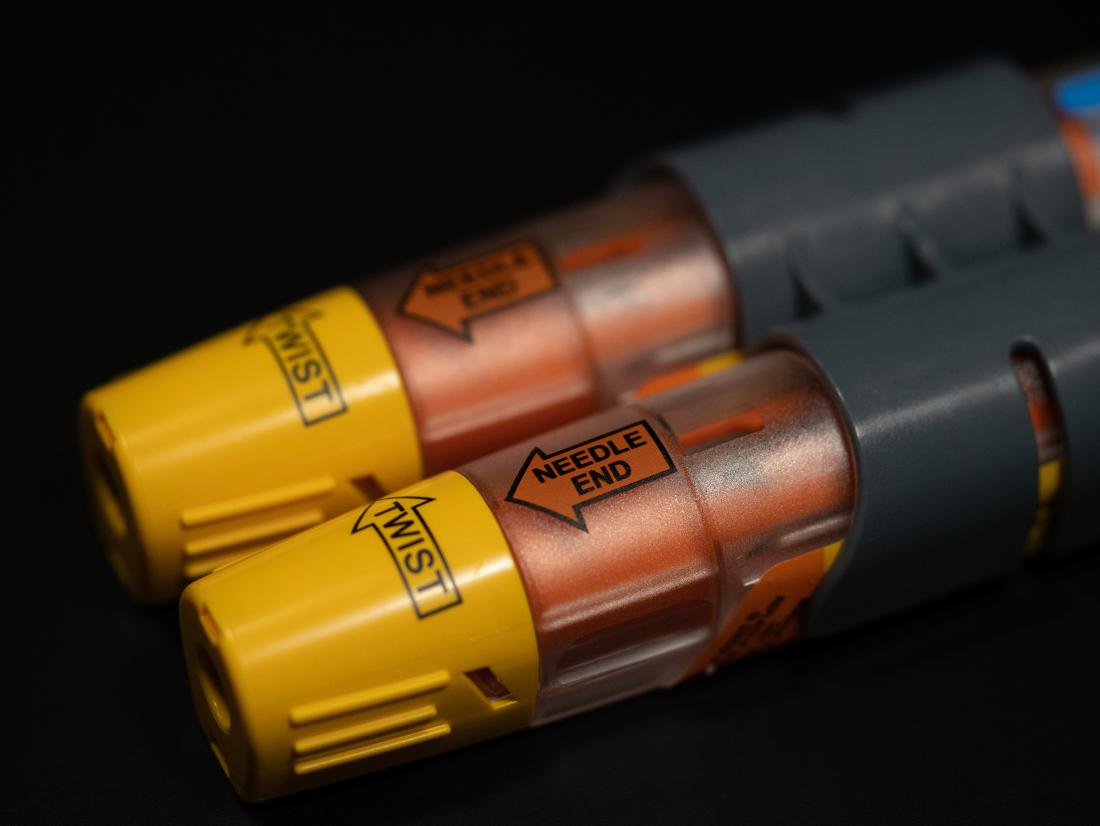People who have allergies to specific foods, insect venom, or other substances often carry an epinephrine auto-injector to self-administer the drug in emergencies. Many people refer to this device by the brand name EpiPen.
Read on to learn more about epinephrine, including when and how to use epinephrine injections.
What is an epinephrine injection?

An epinephrine injection can treat severe allergic reactions.
Image credit: Tony Webster, 2019.
Epinephrine is a natural hormone and neurotransmitter that occurs in the human body.
An injection of synthetic epinephrine through a spring-loaded syringe can act as an emergency medical treatment for severe allergic reactions, including those that occur in response to:
- foods
- insect bites or stings
- latex
- medications
- other substances
The injection delivers a dose of epinephrine, which narrows the blood vessels to increase blood pressure and opens the airways to enable normal breathing.
It is especially important to use epinephrine when a person experiences anaphylaxis. Anaphylaxis is a life threatening allergic reaction that can occur within minutes of exposure to an allergen. Its signs and symptoms include:
- a sudden drop in blood pressure
- difficulty breathing
- nausea
- skin rash
- vomiting
- a weak, rapid pulse
Epinephrine is the only effective treatment for anaphylaxis, including exercise-induced anaphylaxis. It is only available with a prescription.
Brand names for epinephrine include:
- Adrenaclick
- Adrenalin
- Adrenalin Chloride
- Auvi-Q
- EpiPen
- EpiPen Jr
- Twinject
Uses
People primarily use an epinephrine injection for the emergency treatment of severe allergic reactions. People with severe allergies should always carry an auto-injector with them in case of exposure to an allergen.
An epinephrine injection may also treat low blood pressure that results from septic shock.
How to administer

A doctor can give instructions on how to administer a certain auto-injector.
People should administer epinephrine within minutes of the onset of severe allergy symptoms. Failure to treat anaphylaxis increases the risk of death.
To administer an epinephrine auto-injector:
- Form a fist around the device, making sure that the tip is pointing downward.
- Remove the safety cap.
- Place the tip of the auto-injector against the largest part of the outer thigh. Research suggests that the thigh is the most effective injection site. In an emergency, individuals may administer this injection through clothing. If giving the injection to a child, hold their leg firmly in place.
- Press the device firmly into the thigh so that the needle can administer the epinephrine dose. Hold in place for 10 seconds.
- Remove the injector from the thigh and gently rub the skin for 10 seconds.
Some auto-injectors may require a different method of administration. Therefore, individuals should always follow the instructions on the device that their doctor has prescribed.
After use, place the auto-injector into the tube (ensuring that the tip is pointing downward) and put the cap back on. Emergency room staff may wish to see the empty device to understand how much epinephrine a person took.
There is no set dose for epinephrine — it is an emergency treatment that people should use as necessary. Sometimes, people require a second dose or another follow-up treatment.
For this reason, it is vital that people seek emergency medical attention after using an epinephrine injection. In some cases, a doctor will administer further epinephrine directly into a vein.
Other information and tips
Following the advice below can help people use the device correctly and efficiently, maximizing its effectiveness.
- Follow the instructions that accompany the medication — people should familiarize themselves with the information when the doctor first prescribes the auto-injector so that they know what to do in an emergency.
- Discard epinephrine auto-injectors after one use.
- Store the device at room temperature and keep it away from light and heat.
- Make sure that family members understand how to administer this medication.
- Inject only into the muscle of the outer thigh, never into a vein.
When a doctor prescribes epinephrine, it is important that they are aware of a person’s full medical history. Therefore, individuals should be sure to tell their doctor if they are taking any medication or have a history of:
If a woman who carries an epinephrine auto-injector becomes pregnant, she should inform medical professionals that she may require epinephrine. After using an epinephrine injection, pregnant women should seek emergency medical attention.
It is important to check the epinephrine auto-injector regularly and replace it with a new one if:
- it is past the expiry date
- the color changes or the liquid becomes cloudy
- there are particles in the liquid
However, in an emergency, it is better to give an out-of-date epinephrine injection than to give none at all. According to Food Allergy Research & Education, people can safely use epinephrine for up to 9 months after the expiry date, and it can still save lives.
A person should never administer an injection if the color is pink or yellow or if the liquid is cloudy or contains particles.
Side effects and risks

A headache is a common side effect of an epinephrine injection.
Common side effects of an epinephrine injection include:
- anxiety
- breathing problems
- dizziness
- headaches
- nausea
- pale skin
- a rapid heart rate
- sweating
- vomiting
- weakness
Tell the doctor at the emergency department if any of these symptoms occur. Also, inform the doctor if there are signs of infection at the injection site, including:
- pain
- redness
- swelling
- warmth
Symptoms of an overdose include:
- confusion
- difficulty speaking
- sudden weakness on one side of the body
Emergency medical attention is essential if someone is displaying the symptoms of overdose or has other serious symptoms, such as loss of consciousness or seizure.
Epinephrine may also cause other side effects. Anyone who has any queries or concerns should speak to their doctor. People can report side effects to the Food and Drug Administration (FDA) by calling 1-800-FDA-1088 or downloading and completing their reporting form.
Some medications, vitamins, and herbs may interact with epinephrine. People should tell their doctor about any medications or supplements that they are taking.
Summary
Epinephrine is a life saving treatment for severe allergic reactions. People who have allergies should carry an epinephrine auto-injector with them at all times. They and their loved ones should be familiar with how to use the device in emergency situations.
Those who need to carry an epinephrine auto-injector should discuss the possibility of side effects and drug interactions with a doctor before use. As anaphylaxis can be fatal, the benefits of epinephrine usually outweigh the risks.
It is important always to seek emergency medical attention after using an epinephrine injection because further treatment and observation may be necessary.
